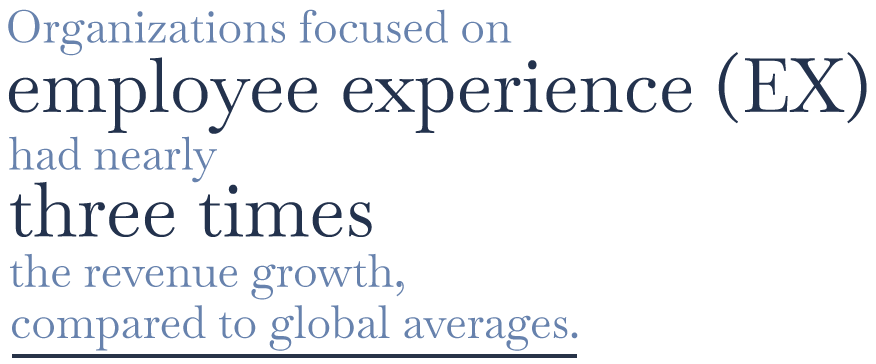Employee Experience and Workplace Culture
6 Min. Read

Employee experience (EX) has long moved from buzzword to Board-level priority, with research consistently demonstrating that organizations who focus on it significantly outperform their competitors. However, it is still a nascent idea for many businesses, with much confusion over what it is, and how you can enhance it. Here we will define what we believe employee experience is and its relationship with corporate culture, highlight the key business benefits it delivers, and include strategies for how you can improve EX in your business.
What is meant by the term "employee experience"?
Employee experience is the combined effect of all the various touch points your people have on their journey with your organization. That process starts sooner than many businesses realise. It begins when a candidate applies for a role at your company, before they have even joined. The way potential recruits are treated throughout the hiring process is your first major ‘moment that matters’ where your EX becomes real.
Other important moments include learning and development opportunities, performance management conversations, and exit handling. These, and many more, demonstrate your EX in action.
What is the difference between employee experience and culture?
Employee experience is not the same as your culture. Let’s look at the difference:
- Culture boils down to the patterns of behaviours that exist within your organisation; those that are encouraged, discouraged, and tolerated over time. The focus is on behaviours, and how they are role modelled by leaders and embedded into key business processes and systems etc.
- Employee experience is about the moments that matter to your people in their employment lifecycle with you. These will be hugely influenced by your culture, and in turn can aid or undermine culture change efforts, but they are not interchangeable terms.
What areas can impact employee experience in the workplace?
There are many aspects that can impact your EX. They include:
1. People managers
They are the single biggest contributor to your employee experience. Indeed, managers account for an incredible 70% of the variance in their team’s engagement. They are the ones having the most interactions with your people, including during nearly all the moments that matter, so they need to be enabled and empowered to deliver the EX you promise.
2. Onboarding
This is critical. Research has shown that when managers play an active role in onboarding, employees are 2.5 times more likely to strongly agree their onboarding was exceptional. It’s the first big opportunity you have for people to feel your culture and values, and how aligned they are to what you promised. How your onboarding is delivered sends powerful messages that will stay with your new joiner. Strong onboarding is also a leading indicator of whether people will stay with you or not.
3. Physical working space
The physical environment that people work in can have a huge impact on employee experience. For example, we have worked with clients whose frontline employees have complained about a lack of heating and water leaks in their building. This doesn’t make them feel valued, hampers engagement efforts, and negatively impacts their EX.
4. Technology
Whether people have the tools to do their job properly has a big bearing on employee experience. We hear a lot about information overload, too many tools, or a lack of access to certain platforms. All of this has an impact on your people’s productivity, efficiency, and wellbeing. The technology you provide must help your employees do their best work.
What are the benefits to organisations of investing in their employee experience?
There are many business benefits to creating a better employee experience. Here are some of the main ones:
1. Better financial performance
According to this report, organisations who focus on EX achieved nearly three times the revenue growth, eleven times the profit margin, and two times the return on equity compared to global averages.
2. Improved customer experience
Prioritising EX creates an environment where your people can thrive, which will boost productivity, engagement, and motivation. There is much research, including this piece, to prove that the better your people’s experience, the better service they will give to your customers. In short, if you value your employees, they will value your customers.
3. Attract and retain employees
When you build a workplace that enables people to do their best work, they are more loyal, and you become a magnet for talent in an increasingly competitive market.
4. Powerful lever of culture change
Delivering an EX that is linked to your target culture will supercharge your cultural evolution, as it will clearly demonstrate at important, symbolic moments (onboarding etc) that your desired behaviours are real; that you walk your talk.
What can leaders do to improve employee experience at work?
Employee experience best practices
For the purposes of this article, I’m going to assume that you know your target culture, and the behaviours you want to see more of. Now you need to view all the moments that matter that comprise your employee experience as opportunities to reinforce your culture change, and to encourage it as much as possible. This alignment between your desired culture, the behaviours you need to embed, and the employee experience that should reflect and deliver them, is essential for sustainable change. When they work in conjunction this is where the magic happens.
An example: Your organisation is trying to increase collaboration. At your global town hall meeting, rather than having the CEO speak, have the other members of the senior leadership team stand together and talk (perhaps even jointly on certain topics). This is a highly visible symbol and behaviour that immediately sends a different message to all your people, at once, about teamwork, and its impact will reverberate throughout your business.
Employee experience initiatives
With any employee experience initiative, the key is to be clear what problem you’re trying to solve and then targeting the moment that matters to address it. To understand the problem, you need to have data and insights – for example, candidate and employee engagement surveys. Within those, you can then identify common issues and opportunities, and build a strategy to tackle them. If you look at a standard employee lifecycle, there are three stand out moments:
1. Onboarding
This is your employees’ first real impression of your organisation. It’s when they are most motivated and want to make a difference quickly.
- So, think about how your onboarding can harness that – what information can you share? Or what early opportunities are there that can make best use of this enthusiasm?
- Also consider how your process aligns with your stated or desired culture? For example, if you say collaboration is one of your core values or behaviours, then having people from different teams come in and talk face-to-face and work with new hires is going to demonstrate that. Show don’t tell.
2. Performance management
This process, and the types of conversations it facilitates, can really improve your EX, and help to embed your culture. But to do this, you need to ensure your line managers are trained and supported to have performance discussions that focus on, and reflect, your desired behaviours.
3. Exit interviews
How people leave your company is what they will remember, and share.
- Firstly, if you don’t do them, introduce exit interviews to ensure leavers feel heard and respected. How you treat people at this moment will also be keenly noted by those who stay.
- Secondly, design this moment so it feels like a positive experience, even if the person may be leaving involuntarily. As much as you can, you want people to leave as promoters of your organisation, regardless of their individual circumstances.
Employee experience initiatives can come from the bottom up, and these are often more focused on areas such as engagement, wellbeing, and mental health. Combining these with a culture blueprint that is aligned to your strategy is a fantastic way to ensure top-down role modelling and bottom up-involvement, which will accelerate your EX roadmap.
How can employee experience at an organisation be measured?
Measurement is essential to track progress, and course-correct if needed. It’s also important to ensure you have a mix of quantitative and qualitative data, so that your people have a variety of channels to give feedback, which will provide you with a holistic picture of their experience. Among the ways you can measure employee experience are:
- Employee Engagement Surveys.
- Candidate Experience Surveys.
- Employee Listening Groups.
- Retention rates.
- Time and cost to hire.
- Absenteeism.
Taking the time to map out, create, and deliver a differentiated employee experience that reflects and reinforces your desired culture will speed up delivery of your strategy and ensure sustainable business performance. In today’s volatile and unpredictable world, that makes prioritising employee experience a no-brainer.
Contact us to learn how we can help you create your target culture and talk more about maximising your employee experience.



